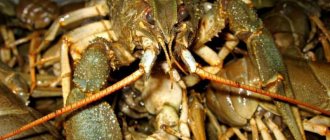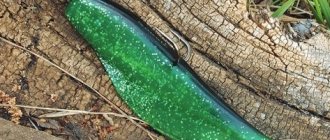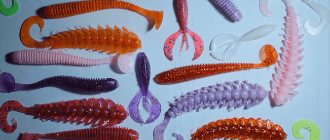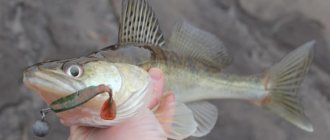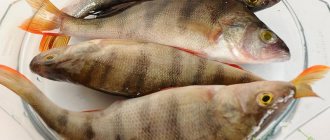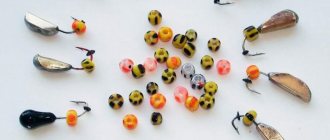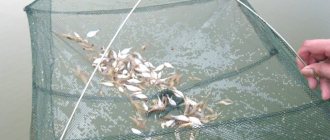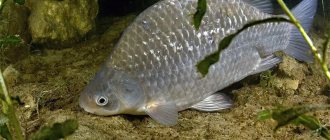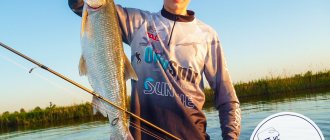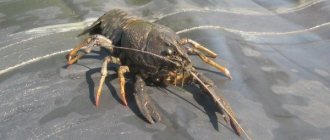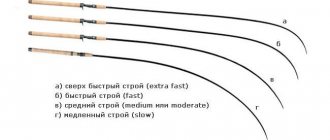Pike is a freshwater species of predator that is especially popular among both experienced fishermen and beginners in this matter. You can fish for it at any time of the year, and spinning is best suited for this, but it will be impossible to return home with a catch if you don’t know the peculiarities of the behavior of this prey, as well as the nuances of choosing equipment.
This article discusses not only the best lures for pike, but also all other issues related to hunting this predator.
Spoons for pike
Choice of spinners
Spoons are one of the most popular lures designed for pike fishing, but choosing the right one can be extremely difficult. For this reason, it is often necessary to have a whole set of different models in order to try them one by one in practice and understand what kind of food a predator prefers in a particular body of water at a given time.
The only exceptions are situations when the pike, for some reason, does not have enough food, then its behavior begins to be characterized by an increased level of aggressiveness, and it begins to grab any bait, as well as attack its competitors.
In other cases, one of the main criteria for choosing a spinner is weather conditions and light levels:
- During clear and sufficiently sunny weather, it is recommended to use white or as light as possible spinners. They will emit glare, which will additionally attract the attention of the predator.
- If the weather is stable and cloudy , then spinners with a yellow color usually show the greatest effectiveness.
- In weather that is changeable and partly cloudy , it is best to use two-color bait options.
You can also give additional tips that can help in the process of choosing a bait of this type:
- The most catchy ones are considered to be spinners belonging to the class of rotating spoons. The optimal size of such bait is No. 3-6, the choice is made depending on the expected mass of the prey.
- The shape of the petals with which rotating spoons are equipped plays an important role. It is recommended to choose models equipped with the following type of petals: Long, which looks like a small willow leaf; Comet, which is the most versatile option, and Aglia, which has a recognizable round shape.
- The presence of a tee edge on the spoon increases its effectiveness , since this element allows you to hold the bait in a horizontal plane, attracts the attention of the pike, increases the weight of the bait and can be treated with flavors that will retain the corresponding smell for a long time due to the characteristics of the material.
- When choosing an oscillating spoon, which with its play and appearance depicts a fish, you must first of all pay attention to its dimensions. This variety will not create significant vibrations when casting, and, therefore, should attract a predator with its size.
The best spinners
To make it easier to navigate the wide range of modern spinners, below are examples of models that show good performance when fishing for pike:
Blue Fox Super Vibrax is an acoustic-type spinner and, due to its catchability, is always popular with most fishermen. The body of the bait is designed in a special way, so it has an additional effect that prevents it from twisting. When wiring, additional vibrations will be created that will attract the attention of the predator. Depending on the size and color, the price ranges from 150 to 220 rubles.
Mepps Aglia Long is a classic type spinner, made in the shape of a willow leaf. Many people use it when fishing in places with rapid currents, since even in such conditions the spoon retains its natural action. Lures of sizes suitable for pike fishing cost from 200 to 450 rubles.
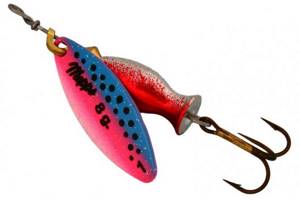
Mepps Syclops is a spinner, the main secret of which is the presence of ten facets of light reflection. The game is natural and persists at any speed, which makes this bait not only effective, but also a universal option. The approximate cost is 950-1000 rubles.

User voting
Which lure for pike will you choose or recommend?
Mepps Aglia Long №3
28.57 % ( 4 )
Kuusamo Professor 3
14.29 % ( 2 )
Kuusamo Rasanen
7.14 % ( 1 )
Williams Wabler
21.43 % ( 3 )
RB Atom-N
0.00 % ( 0 )
Rapala Minnow Spoon
7.14 % ( 1 )
Mepps Black Fury
7.14 % ( 1 )
Daiwa Silver Creek Spinner
0.00 % ( 0 )
Lucky John Shelt Blade 03
0.00 % ( 0 )
Wobblers
Choosing bait for pike
Wobblers have gained significant popularity in recent years and have become worthy competitors to spinners, this is primarily due to the wide range and variety of modern models presented on the fishing market.
However, this factor often complicates the process of choosing the most suitable bait option, so below are features that can help fishermen in this process:
- The length of a wobbler for pike can be from 5 to 20 cm, this parameter depends on the size of the potential prey. The largest models are used for fishing for trophy specimens.
- The depth level is a characteristic of a wobbler, which directly depends on the angle of inclination of the blades: elements located perpendicular to the main surface of the bait indicate that it is of the surface type. The maximum value for river models is usually 10-15 meters; selection in accordance with this parameter is necessary based on the depth of a particular reservoir and the places where the pike is located at the time of fishing.
- According to the level of buoyancy, all models of wobblers can be classified as floating , sinking and universal, which can remain in the water column for a long time. The choice of bait in accordance with this criterion depends on the current location of the prey and the characteristics of the fishing conditions.
- Features of the wobbler game, which can be passive or, conversely, distinguished by its activity. For catching pike, the first option is usually used, especially in the summer, when this predator prefers to grab slow fish and not chase prey that is too fast.
- The color of the wobbler is chosen based on the same considerations as when fishing with a spoon, that is, it depends on the weather and light level. You can also focus on the diet of pike in a particular body of water, choosing models that look as similar as possible to its usual prey.
The best wobblers
In order to make it easier to choose wobblers for pike fishing, below are examples of models that have proven themselves to be the best:
Yo-Zuri L-Minnow F200 (66) is a sinking type wobbler; its use is justified in situations where a predator needs to be lured out from a considerable depth. The action of this bait is distinguished by its activity, and the design features easily allow you to make long casts and add stability when making a retrieve. The approximate cost is 350-400 rubles.
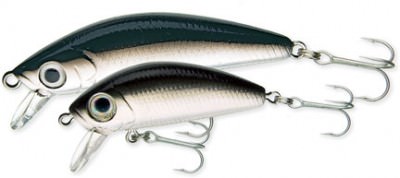
Salmo Slider is a wobbler from a leading manufacturer of lures of this type; it consistently shows good results and is very often used during periods when pike are passive, since it is guaranteed to attract the attention of a predator. The approximate price is 600 rubles.

The Zip Baits Rigge 90F is the largest option in its range and is ideal for pike fishing. It belongs to the sinking type of bait, therefore it is effective when it is necessary to lure a predator from the bottom and retains all the main advantages of its type. The price for such a wobbler is about 1000 rubles.
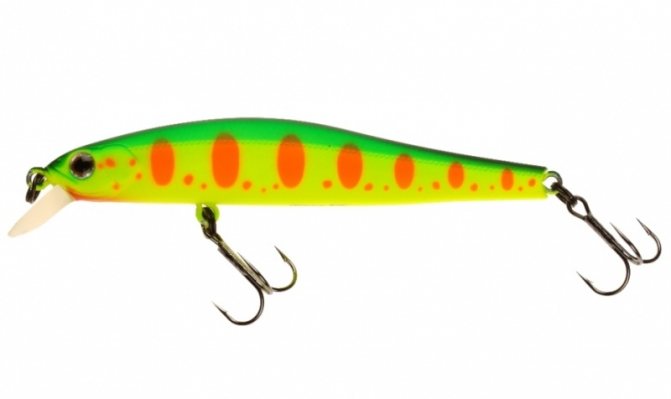
Jig baits
An alternative option is to use jig baits, which in most cases are universal and suitable for different breeds of predators.
However, pike baits of this type still have a number of individual characteristics, which are discussed below:
- The speed of penetration is one of the determining criteria ; it is necessary to choose options that sink to the bottom surface slowly enough, periodically pausing for 10 seconds.
- The jig bait used must correspond not only to the breed of predator that you plan to fish for, but also to the test parameters of the rod itself. This is necessary in order to promptly notice even the most insignificant and unnoticeable bites.
- The weight of the sinker usually depends only on the direction and speed of the current: the stronger it is, or when fishing against the current, you need to use heavier options.
- Size and shape also play an important role: a jig bait for pike should be large enough for a predator to notice it, as well as voluminous and have an elongated shape.
- The color is chosen depending on the fishing conditions , it is influenced by the usual diet of the predator in a particular body of water, the topography and structure of the bottom surface, the level of lighting and the transparency of the water itself.
- Among the assortment of such baits you can find full-fledged painted baits or separate heads with eyes ; both options are suitable for pike fishing; this design feature does not affect efficiency.
LUCKY JOHN 3D Series MAKORA SHAD TAIL
LJ 3D Series MAKORA SHAD TAIL is another interesting vibrating tail from Lucky John, which is made in 3D technology. This vibrotail differs from all previous ones by its unique foil insert inside the bait, which precisely gives high realism to this bait. This model is very popular in clear water.
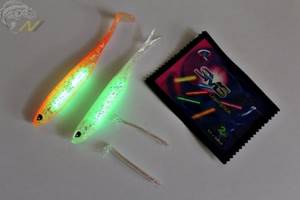
Makora Shad Tail lures are available in 4 sizes: , , and 6 inches. All sizes work great when catching spotted predators. They are currently only available in 7 colors. All available colors work well for pike, but of them there are 2 favorites: colors 001 and 006. The bait goes well with a jig head. It is easily and conveniently equipped with an offset and double hook. It is allowed to install leash accessories, such as: diverter leash.
Author/Source: Yuri Yurasov
Homemade lures for pike
Lures intended for pike fishing do not necessarily need to be purchased in stores, since they can be made with your own hands at home. One of the simplest and most popular ways to make homemade bait is to use a teaspoon handle made of steel or cupronickel for this process.
To implement this idea, you can use the following algorithm of actions:
- It is necessary to choose a handle from a teaspoon, which has bends on each side , which will significantly increase the catchability of homemade gear.
- Holes are made with a drill on each side of the handle: one will be intended for fastening the hook, and the other for the working line.
- If the spoon was too large, then from the side that is narrower, you can remove a piece 1.5-2 cm long ; such a measure will give the bait a visual similarity to the bleak that pike likes to hunt for.
- The tee is attached to the opposite side of the handle , which has a larger width.
- If desired, the tee can also be secured on the narrow side, which will allow you to get a homemade version of a Devon-type spoon. This option has one significant advantage, which is to significantly reduce the risk of losing the bait when making transactions.
After complete manipulations with the handle, it is not necessary to throw away the remaining part of the spoon, since it will be possible to make a different type of bait from it:
- Using a file , carefully sand the area where the handle was cut.
- Two holes are drilled on each side: a tee hook is fixed using one, and a fishing line is passed through the other.
- The ring that will be used to fasten the tee should be twice as large as the hooking element , which will improve the wiring during fishing and make the bait play much more believable and natural.
Following the above instructions allows you to obtain an analogue of a spinner, characterized by perfect symmetry. You can use the part of the spoon without a handle, made of aluminum; this material has a specific feature that allows it to produce an additional acoustic effect when making a retrieve, which attracts the attention of a predator and provokes it to attack.
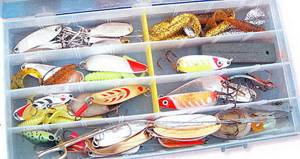
One of the simplest and most popular ways to make homemade bait is to use a teaspoon handle made of steel or cupronickel for this process.
Other lures for pike
The article examined the most popular lures for pike fishing, which have proven themselves on the positive side and are always popular with many fishermen.
But there are other varieties that are often no less effective, they are discussed in more detail below:
- Live bait. Small fish such as gudgeon or roach are best suited for pike fishing. If a predator in a particular body of water is accustomed to hunting other species, then they can also be used to increase the likelihood of a bite. Fishing with live bait has a number of advantages over using artificial bait, the main ones being the attractive natural smell, natural play and unpredictability of bait behavior.
- Using a popper. At its core, it is a subspecies of spinners, which differs in its design features. They consist in the presence of special holes in the surface of the bait, which create a background noise during wiring, which can attract predators to the fishing site even from a very long distance. There is still debate among professional fishermen regarding the usefulness of this effect and its impact on the bite, but many people still note that poppers gave a positive result in a number of cases when other baits did not bring it.
“Super bite” electronic fish bait: reviews
Many fishing enthusiasts managed to test the new electronic product on reservoirs.
Consumer reviews are quite ambiguous, although in each specific case it is necessary to deal with the cause of the lack of bites on an individual basis.
- Novice fisherman Alexey considers electronic bait complete nonsense. While fishing, he observed the opposite picture. For some reason, the fish began to bite only after Fishmagnet-2 was removed from the water.
- But the experienced fisherman Fedor was given the device by a fellow hobbyist. Testing this coming weekend showed the device to be highly effective. Fedor was pleased with the electronic bait.
- Oleg, a fishing enthusiast, observed an interesting picture on the pond. His friend arrived at the lake with an electronic novelty. Compared to neighboring fishermen, his catch was much better.
- Vovan believes that many simply do not know how to use the device. It was only on his third fishing trip that he revealed all the secrets of its use. The fisherman advises that the main emphasis be placed on selecting the immersion depth of the electronic device.
Selection of baits depending on the season
Pike fishing can be done all year round, but the characteristics of each season have a tremendous impact on the choice of bait. In order to facilitate this process, the behavior of the predator will be examined in detail by season, which will allow fishermen to choose the right bait.
Spring
Spring fishing is very effective, since the pike begins to eat after the winter hunger strike and now needs to replenish its energy supply.
Fishing features by month are as follows:
- In March, pike usually still remain passive, because the ice has not left the reservoirs or the water simply has not had time to warm up enough. To get a catch, you will have to lure the prey from an impressive depth; for this, small baits with a quick dive are usually used. During March fishing, it is best to use jig baits.
- April fishing largely depends on the climatic conditions of a particular area, but in most cases it is not fundamentally different from fishing in March: pike will have to be lured with a jig from great depths.
- In May, the water warms up and the predator rises closer to the surface of the water , so the jig bait can be safely replaced with floating wobblers or suspenders, which give good results.
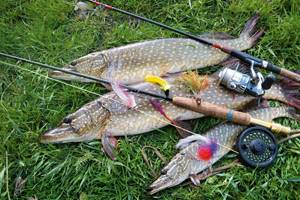
To get a catch, you will have to lure prey from an impressive depth; for this, small baits with a quick dive are usually used
Summer
Summer fishing is stable if the main prey is pike. The bite is usually absent only in the hottest weather, when the predator goes to the bottom to hide from the sun's rays.
The selection of baits by month is as follows:
- June is a good period for catching this predator ; it shows a sufficient level of activity and responds well to baits with an aggressive color, especially if you catch it in shallow water.
- In July, the bite decreases slightly due to hot weather ; to get a catch, you need to use bait that is most similar to the fish that are part of the pike’s diet. Since she does not like to chase fast prey during the heat, it is necessary to use only slow wiring.
- The predator's behavior changes around mid-August , when the heat gradually subsides and the fish's appetite awakens. The principles of fishing do not differ from those used in June, but with the onset of cold weather, you will need to look for prey closer to the bottom surface.
Autumn
Autumn fishing is also characterized by good productivity, since the predator needs a fat reserve, which it will need in winter, so it begins to actively feed.
There are the following fishing features by month:
- In September the bite is quite good, but has not yet reached its peak levels. It is best to use baits with fast and significant depth, as the pike begins to sink closer to the bottom surface. An exception can be made only for morning fishing, when a predator rises up to hunt fry.
- In October, sufficiently large wobblers or spinners of the oscillating type can show the greatest effectiveness. Locating the location of prey can be very difficult, since it can sink closer to the bottom or rise to the surface of the water. It is recommended to choose baits that are exclusively dark tones and have a natural color.
- November is the period when most fishermen go looking for pike, as they are one of the few species that continue to bite into the last month of autumn. Jig baits are most effective at this time, and it is best to look for prey at great depths, where it descends after the favorite object of hunting - fry.
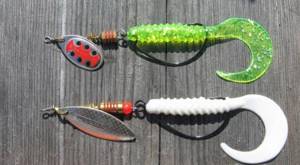
In September, it is best to use baits with fast and significant depth, as the pike begins to sink closer to the bottom surface
Winter
Winter fishing does not have any particular differences between months, so it is enough to give general recommendations, which are as follows:
- After the first ice appears, it is necessary to use baits that do not sink to the bottom, but linger longer in the upper layers of the water.
- A significant role during winter fishing is played not so much by the choice of a specific type of bait as by the discovery of prey sites.
- The periods after ice formation, immediately before it melts , and also during thaws are the most favorable for fishing.
- At the end of winter, you can start using a special type of fishing rod - a zherlitsa, which shows high efficiency when fishing with live bait.
The best non-hooking spinners
If we compare the non-hooking models with the analogues discussed above, they are basically similar in many ways, but have a distinctive design part. They always have a single hook, complemented by an anti-hook part in the form of a small flap. When the user is guiding through grassy areas, it will protect against getting stuck in algae and snags, and at the moment of biting it will open freely, releasing the sharp part of the prey. After analyzing the reviews and opinions of experts, the best non-snappy hooks of 2021 were found.
Rapala Minnow Spoon RMS10-SH
When considering a non-hooking spinner for pike in the most inaccessible areas, the Minnow Spoon RMS10-SH from the legendary Finnish brand Rapala is considered a worthy offer on the market. Her magnificent game is not interrupted in any condition, be it active retrieving or a motionless dive to the bottom. If the prey lives in waters with thick algae, effective hook protection will prevent entanglement. The manufacturer recommends using the spoon in fresh and salt water.

Advantages
- Request for any distance;
- Game stability;
- Aerodynamics;
- Anti-corrosion coating;
- Good imitation;
- Hook protection from snags;
- Manual setting.
Flaws
- Needs a load due to its light weight;
- Price.
Professionals in their field prefer to purchase any equipment from the Rapala brand. They value functionality, quality, long service life, and high catch rates. The disadvantage of such a non-hooking device is that some reviews note the light weight and the need to attach additional weight, as well as the price.
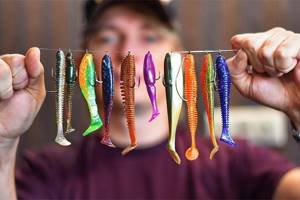
The best vibrotails
Kuusamo Professor 3, 75/12 (non-hook) FYe-S
This non-hooking line from a major brand demonstrates high fishing efficiency in slow-flowing or stagnant bodies of water. The culmination of vibrations that attract a predator is guaranteed by the thoughtful lines of the petal, its filigree contours, and the optimal ratio of all edges. The main object of such a device is pike, although hunting for perch and pike perch shows good results. The sweeping fall reduces the speed of immersion in water, and the proprietary double with a wire frame promotes good maneuverability.
Advantages
- Universal colors;
- Branded double;
- Anti-snatch protection;
- Good catch;
- Thoughtful petal geometry;
- Suitable for all bodies of water.
Flaws
- Price;
- Not always on sale.
Another brand that is valued by professionals offers a good model for fishing in any body of water, for any predator. The efficiency does not decrease even in stagnant waters with dense vegetation on the bottom. But you need to understand that for good fishing with such an assistant you will have to pay more than other companies ask. And the Kuusamo Professor line is not always available in stores.
Blitz tips
To summarize, we can give the following tips and recommendations regarding pike fishing:
- When fishing for pike, you need to pay attention not only to the bait you use, but also to the rest of the equipment. It is recommended to always use strong leashes, since this predator has sharp teeth and is capable of cutting through the main fishing line.
- If there is no bite or the pike behaves passively, then you can use bite activators , special pheromones for processing bait, or increase the sensitivity of the fishing rod used.
- You should not pay too much attention to the reels; standard options will do, the main thing is that they have a friction brake and smooth running , and are also capable of reeling in at least 50 meters of fishing line with a diameter of about 0.25 mm.
